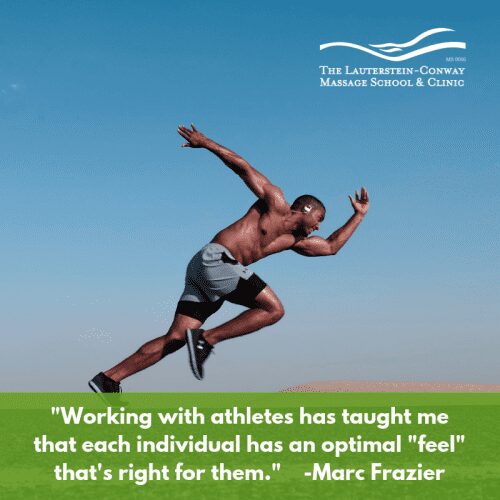by Marc Frazier, LMT, NSCA
Almost from the start, my massage career has included a lot of regular work with competitive athletes. This was not something I chose to do, it just sort of happened. In fact, I remember someone telling me at the end of my second semester of training at The Lauterstein-Conway Massage School, that they guessed that I would be focusing on sports massage.
To this statement I replied that I had no intention of doing massage at all. I had really gone through massage school to better learn anatomy for my career as a personal trainer.
And while I really liked giving and receiving massage, I didn’t see how it would fit into my plans.
A few months later, I was waiting for a massage client to show up. And when the guy at the front desk of the gym asked who it was, I told him Donovan Bailey.
He looked at me and said, “You don’t even know who that is, do you?”
I said, “No.”
He said, “Donovan Bailey is the fastest man in the world! He’s coming to you for a massage, and you don’t even know who he is?”
Well, I quickly learned who he was. He was a very large muscular man who wanted very deep work on his entire muscular system. So it seemed I was going to get plenty of practice in the anatomy training I had wanted!
#1. You Really Learn Anatomy
In fact, working with Donovan – and a whole lot of people like him (i.e. competitive athletes who know their body and want regular massage from therapists who can understand their bodies) – is the first way I would come to realize how massaging athletes would help my career:
You really learn the body by regularly working with a good specimen.
#2. What Works?
Competitive athletes use their bodies much more than the average client. This is especially true of swimmers, who will often train twice a day, almost every day, during all of their competitive years. When someone puts their body through that much work, they are likely to rack up a lot of aches and pains.
In fact, nearly every truly competitive athlete is constantly on the verge of very real injury, which is why so many of them turn to massage to help keep their bodies going.
What I have found over the years is when we tried various massage techniques I thought would be beneficial, they would have gone through their training as many as four of five times by the time I saw them again (sometimes later that week). Then they would know if the technique in question had helped or not.
This meant that we both learned ways that massage could help them in their training regimen. For me, it also meant that I learned how to assist my non-athletic clientele. After all, we’re still talking about the human body. So, the second way that regularly working with athletes helps me is that it provides fast and reliable feedback.
#3. You Can Go By Feel
The third way working with athletes has helped me is that it taught me that each individual has an optimal “feel” that’s right for them.
Five specific examples of this come to mind:
Three are swimmers who have won gold medals, one is a professional (closing)
pitcher, and one is nationally ranked runner specializing in 5Ks. Two of the
swimmers, who frequently set world records (each specializing in different events
and distances), are more likely to have outstanding performances when their
bodies felt like limp noodles. The closing pitcher and the runner perform their
best when there is some palpable tension in their muscles. When they are loose,
they consistently do not perform well. With the third swimmer, for his optimal
performance, we shoot for somewhere in the middle.
After years of noticing this, I also realized that the same thing seemed to be happening with my regular clients who have chronic injuries and the regulars who just come to relax. I was then able to understand that every body had a different feel – one in which I could learn to recognize – the way I might recognize someone’s face or their voice. That makes my job a lot simpler: I can now just go by feel.
Of course, all of these aids come to me primarily through the regularity of sessions with the same client, more than anything else. But, I often look back at my early days as a massage therapist and am really grateful that I ended up stumbling down the path I did.

